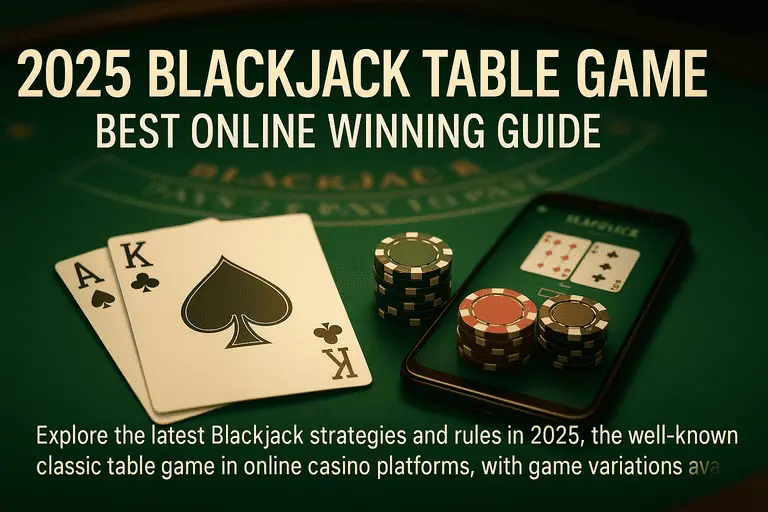
2025-10-28
2025 Blackjack Table Game – Best Online Winning Guide

Want to play smarter and more consistently in 2025? Blackjack is one of the most classic table game options on online casino platforms. This guide explains what Blackjack is, how to play, the round flow, and common game variations. It helps you grasp Blackjack rules, estimate winning odds, understand the key rules that shift the house edge, evaluate table settings, manage risk, and allocate your bankroll.
Use these strategies to avoid tables where the dealer’s advantage is higher and build a practical table game field manual you can apply to your decision process when playing casino games online for real money.
table of content
What Is Blackjack? Classic Table Game
In most online and land-based table game pits, Blackjack is a classic player-versus-dealer game. Your goal is to beat the dealer by getting closer to 21 without busting.
Unlike online poker, this table game rewards disciplined play. Turn information and probability into a repeatable process to keep variance manageable and improve long-term expectation. That is why Blackjack is easy to learn but hard to master, and is widely popular as a classic table game.
Why is Blackjack a classic table game?
Blackjack has a low learning curve, a clear decision tree, and fast feedback. Beginners can start quickly. Advanced players who enjoy online poker can continue optimizing. If you already know poker rules, the payout math and decision logic will feel intuitive.
Remember: your goal is to beat the dealer without busting, not to “make 21.”
Card values and key terms
In Blackjack, every card has a set value. An Ace counts as 1 or 11. Cards 2–10 take their face value. J, Q, and K each count as 10. A starting hand of an Ace plus any 10-value card (10, J, Q, or K) is called a natural (Blackjack). It is the strongest opening hand. The exact payout depends on the table rules; later in this guide, we compare the 3:2 and 6:5 payouts.
How to Start Playing Blackjack? Game Variants and Basic Rules
Before you start, read the table card and rules. Check S17/H17, whether Surrender is offered, whether DAS (Double After Split) is allowed, the number of decks, and the Blackjack payout.
Blackjack hand types
A starting hand of an Ace plus any 10-value card (10, J, Q, or K) is a natural (Blackjack) and usually pays better, depending on the table rules. A hand where the Ace counts as 11 without busting is a soft hand; otherwise, it is a hard hand. Knowing soft versus hard helps you apply the basic strategy chart faster. Two cards of the same rank form a pair, and you may choose to Split under the table game rules; some tables also allow Re-split.
These bankroll and discipline frameworks, which are similar to poker rules, directly affect expectation and your overall strategy. Check the rules before you sit. It keeps your table game decisions consistent and is the first step toward better results.
Game variants
Blackjack rules vary by region and table, and those differences affect your strategy and long-run expectation. Common variants include:
- American (hole card) vs European ENHC (no-hole-card): Under ENHC, if the dealer makes Blackjack, any extra stakes from Double or Split also lose.
- H17 vs S17: S17 means the dealer stands on soft 17; H17 means the dealer hits soft 17. S17 is usually more favorable, and the basic strategy shifts slightly.
- Number of decks: Fewer decks generally help the player, though casinos may offset this by restricting features such as DAS.
- DAS (Double After Split): DAS allows you to double after a split so you can increase the stake on each split hand.
Blackjack Round Flow Strategy and 8 common Blackjack mistakes
Want to make a repeatable Blackjack table game decision process? Review the round flow and avoid these eight mistakes to grasp the essentials fast, whether or not you have online poker experience.
Round flow
Before each round, confirm S17/H17, whether Surrender is allowed, whether DAS is offered, the deck count, and the Blackjack payout (3:2 vs 6:5). As with poker rules, assess these conditions to judge table friendliness and switch if the rules are not player-friendly.
After you receive your first two cards, identify the hand type: hard, soft, or pair. Then use the basic strategy chart that matches the current rules and deck count to Hit, Stand, Double Down, or Split. The dealer reveals the hole card and draws to 17 by rule; S17 vs H17 determines whether the dealer hits a soft 17.
8 Common Blackjack Mistakes
- Playing without checking rules: Always confirm H17/S17, DAS, Surrender, and 3:2 vs 6:5.
- Not using a basic strategy chart: Match your chart to deck count and H17/S17.
- Buying Insurance: Decline in regular play unless you count cards.
- Wrong split decisions (e.g., splitting 10s): Keep 10,10 and stand in most cases.
- Missing or misusing Double Down: Follow the chart because doubling windows change by rule set.
- Misidentifying soft hands: Track Ace as 1/11 first, then consult the chart.
- Aiming only for 21: Focus on beating the dealer, not just hitting 21.
- Progressive betting to chase losses (Martingale): Staking systems do not change long-term expectation; they only increase volatility and risk.
6 Hidden Rules in Blackjack That Change Your Edge
Want more of an edge? Learn how hidden table game rules shift the house advantage: payout ratio, S17 vs H17, ENHC, DAS, and deck count. This list helps both beginners and advanced players.
1. Payout Ratio Comparison: 3:2 vs 6:5
Choose 3:2 when available. For naturals, 3:2 pays 1.5× while 6:5 pays 1.2×, about 30% less per natural.
2. Dealer on Soft 17: S17 vs H17
H17 is worse for players than S17 because the dealer draws an extra card. Favor S17 when other conditions are equal.
3. ENHC (European No-Hole-Card)
Under ENHC, if the dealer has Blackjack, your extra stakes from Double or Split also lose. Play doubles and splits more conservatively, especially against a dealer Ace or 10.
4. DAS and Deck Count
Tables without DAS reduce player flexibility for optimal plays. Fewer decks usually help the player, but some single-deck games offset this with 6:5 payouts.
5. Put Bankroll Management Into Practice
Strong Blackjack play requires rules knowledge and strict bankroll control. Set a session bankroll and unit bet. Define stop-loss and take-profit limits. Avoid emotional decisions.
6. Build Your Personal Field Manual
Blackjack rewards discipline and information. Learn the rules first to get ahead. Create a field manual that prefers 3:2 payout, S17, DAS allowed, and avoids ENHC. Confirm S17/H17, payout, Surrender, DAS, and ENHC because these rules shift the house edge and your strategy.
Use a Blackjack basic strategy chart to screen tables for both online and in-person table game play:
| Rule item | Ideal setting (choose first) | Avoid / relative impact on player expectation | Practical SOP |
| Payout | Blackjack 3:2 | 6:5: house edge up by about 1.39% | If you see 6:5, change tables; practice and play on 3:2 |
| Dealer on soft 17 | S17
(stand on soft 17) |
H17 (hit on soft 17): player expectation decreases by 0.22% | Prefer S17; if you must play H17, keep strict P/L standards |
| Hole card rule | American with hole card
(non-ENHC/peek) |
ENHC / no-hole-card: player expectation decreases by ~0.11%; doubles/splits also lose if the dealer has Blackjack | Avoid ENHC; if ENHC, be conservative with Double/Split vs dealer Ace/10 |
| DAS (double after split) | Allowed | Not allowed: player expectation decreases by ~0.14% | Prefer “Double After Split Allowed,” else switch or adjust strategy |
| Decks | Fewer is better
(all else equal) |
Single deck vs 6–8 decks: player expectation increases by ~0.48% | Prioritize 3:2 and S17, then favor fewer decks; beware “single-deck + 6:5” |
| Surrender | Allowed | Allowed Surrender: +0.08% for the player | Use Surrender in tough spots (e.g., 16 vs dealer 10) to reduce losses |
Before playing casino games online for real money, review the license, rules, payout terms, and withdrawal policies. Avoid Insurance in regular play, and never chase losses with larger bets. With these habits in place, you can build a repeatable decision process for Blackjack and stabilize your results over time.
Join Diwata Play Casino Games Online for Real Money
Want the best Blackjack experience? Diwata Play is a trusted online casino platform offering player-friendly table game rules, secure encryption to protect your data, and a wide range of casino games online for real money, including online poker and arcade titles, plus 24/7 professional support!
On top of that, Diwata Play is launching a seasonal Halloween event, “Happy Halloween!! Pumpkin Happy Spin!!”. Sign up now for daily chances to win spinning tickets, with bonuses up to ₱10,310 and an iPhone 17 Pro Max jackpot prize.
FAQs
How much better is 3:2 than 6:5, and why should I avoid 6:5 in most cases?
When all other rules are equal, switching the Blackjack payout from 3:2 to 6:5 increases the house edge by about 1.39%, which erodes long-term results. Choose 3:2 when possible.
Should I split a pair of 10s?
Mainstream guidance says to stand on 10,10 in nearly all situations unless a specific rule set and a card-counting strategy justify otherwise.
What do S17 and H17 mean, and which is better for players?
S17 means the dealer stands on soft 17; H17 means the dealer hits soft 17. Changing S17 to H17 typically worsens player expectation, so S17 is preferable.
Is Insurance worth buying?
For non-counters, Insurance has a negative long-term expectation, so it is usually best to decline it.
How do I choose a reliable online casino to play Blackjack?
Diwata Play is a solid option for newcomers, with smooth deposits and withdrawals, plus cross-device support, so you can play on this online casino anytime.
